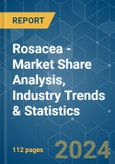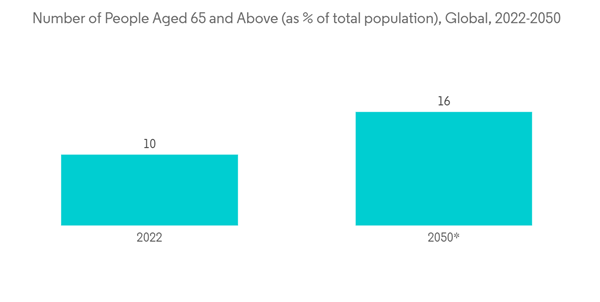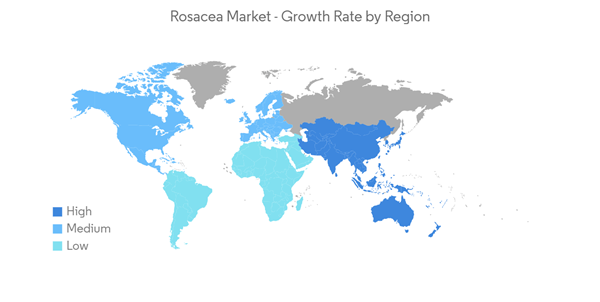The Rosacea Market size is estimated at USD 2.09 billion in 2024, and is expected to reach USD 3.19 billion by 2029, growing at a CAGR of 8.74% during the forecast period (2024-2029).
COVID-19 had a significant impact on the growth of the market during the pandemic period. This is mainly due to the worsening of the rosacea condition due to the COVID-19 protection kits.
For instance, according to the article published in February 2021, a survey conducted by Galderma suggested that the pandemic may impact rosacea patients by worsening of signs and symptoms related to mask-wearing, and there were reduced healthcare professional consultations. Thus, the demand for rosacea treatment due to the COVID-19 outbreak contributed to the market's growth during the pandemic period. However, the pandemic has subsided, so the studied market is expected to grow generally during the forecast period.
The growth of the market is attributed to factors such as the increasing prevalence of rosacea among the global population. For instance, the article published by the International Journal of Dermatology in December 2021 mentioned that 2.1% of the survey participants had rosacea. The prevalence of rosacea increased significantly with age. The report also mentioned that Rosacea is a common skin condition most prevalent above the age of 65.
Moreover, according to World Health Organization (WHO) data published in October 2021, it is estimated that 1 in 6 people worldwide will be aged 60 years or over, in seven years. The share of the population aged 60 years and over will increase to 1.4 billion. The world's population of people aged 60 years and older will double (2.1 billion) in 27 years. The number of persons aged 80 or older is expected to triple in 27 years to reach 426 million. Thus, the rising geriatric population worldwide is also expected to boost the growth of the rosacea treatment market.
Moreover, the rising developments by major market players are also expected to boost market growth. For instance, in June 2021, Sol-Gel Technologies and Galderma announced the signing of two exclusive five-year license agreements for the commercialisation of Epsolay and Twyneo in the United States.
Therefore, with rising prevalence, the awareness among physicians and societies has also increased, further driving the demand for this market. However, the presence of generic drugs to curb the related symptoms hinders the growth of the rosacea market.
Oral antibiotics, such as tetracycline, doxycycline, and minocycline, have been proven to control rosacea's bacterial component and have inflammatory benefits. For instance, according to the article updated by the National Center for Biotechnology Information (NCBI) in June 2022, doxycycline is used only to treat pimples and bumps caused by rosacea. It is most commonly preferred by physicians and doctors for early relief from the disease. Still, it is usually for an extended period, which drives this segment's sales over other sub-segments. So, the high usage of antibiotics for the treatment of rosacea is the main factor for the growth of the market.
Furthermore, in the article updated by NCBI in August 2021, metronidazole is an antibiotic cream or gel used to treat rosacea. The study also mentioned that patients who regularly used metronidazole saw their rosacea-related pustules and papules by between 40% and 65%. Such reduction of rosacea-related skin conditions is expected to contribute to the growth of the studied segment. Moreover, as rosacea is often common in older people, the rising geriatric population is also a major factor driving the segment growth. Thus, the above-mentioned factors, such as the rising geriatric population and the high efficacy of antibiotics in rosacea treatment, are expected to drive the growth of the studied segment over the forecast period.
For instance, according to the data updated by The National Rosacea Society in 2021, the National Rosacea Society designed April as Rosacea Awareness Month to educate the public on this potentially serious disorder. Moreover, as per the data updated by the American Academy of Dermatology published in September 2021, about 16 million Americans suffer from rosacea, and maybe millions more are in temporary remission.
Moreover, the companies also prefer to release their products first in the United States due to favorable regulatory requirements, which drive the demand for this market. For instance, in April 2022, Sol-Gel Technologies, Ltd. received the Food and Drug Administration (FDA) approval of its drug product, EPSOLAY, a proprietary cream formulation of benzoyl peroxide, 5%, for the treatment of inflammatory lesions of rosacea in adults. The benzoyl peroxide in EPSOLAY is encapsulated within silica-based patented microcapsules. The silica-based shell is designed to slowly release benzoyl peroxide over time to provide a favorable efficacy and safety profile.
Similarly, in June 2022, Galderma announced the availability of EPSOLAY (benzoyl peroxide) cream, 5%, in the United States following approval by the United States Food and Drug Administration (FDA). EPSOLAY Cream is a microencapsulated benzoyl peroxide (E-BPO) topical treatment proven to relieve the bumps and blemishes of rosacea and provides rapid, significant and sustained relief.
Thus, the factors mentioned above such as the rising awareness about rosacea and the increasing developments by major players, are expected to drive the growth of the market in this region over the forecast period.
This product will be delivered within 2 business days.
COVID-19 had a significant impact on the growth of the market during the pandemic period. This is mainly due to the worsening of the rosacea condition due to the COVID-19 protection kits.
For instance, according to the article published in February 2021, a survey conducted by Galderma suggested that the pandemic may impact rosacea patients by worsening of signs and symptoms related to mask-wearing, and there were reduced healthcare professional consultations. Thus, the demand for rosacea treatment due to the COVID-19 outbreak contributed to the market's growth during the pandemic period. However, the pandemic has subsided, so the studied market is expected to grow generally during the forecast period.
The growth of the market is attributed to factors such as the increasing prevalence of rosacea among the global population. For instance, the article published by the International Journal of Dermatology in December 2021 mentioned that 2.1% of the survey participants had rosacea. The prevalence of rosacea increased significantly with age. The report also mentioned that Rosacea is a common skin condition most prevalent above the age of 65.
Moreover, according to World Health Organization (WHO) data published in October 2021, it is estimated that 1 in 6 people worldwide will be aged 60 years or over, in seven years. The share of the population aged 60 years and over will increase to 1.4 billion. The world's population of people aged 60 years and older will double (2.1 billion) in 27 years. The number of persons aged 80 or older is expected to triple in 27 years to reach 426 million. Thus, the rising geriatric population worldwide is also expected to boost the growth of the rosacea treatment market.
Moreover, the rising developments by major market players are also expected to boost market growth. For instance, in June 2021, Sol-Gel Technologies and Galderma announced the signing of two exclusive five-year license agreements for the commercialisation of Epsolay and Twyneo in the United States.
Therefore, with rising prevalence, the awareness among physicians and societies has also increased, further driving the demand for this market. However, the presence of generic drugs to curb the related symptoms hinders the growth of the rosacea market.
Rosacea Market Trends
Antibiotics Segment is Expected to Have a Significant Market Share During the Forecast Period
Antibiotics have been prescribed as a treatment for the symptoms of rosacea for an extended period. It can reduce the number of acne pimples and bacterial inflammation or redness around the acne pimples. Antibiotics are available in two forms, including oral antibiotics and topical antibiotics.Oral antibiotics, such as tetracycline, doxycycline, and minocycline, have been proven to control rosacea's bacterial component and have inflammatory benefits. For instance, according to the article updated by the National Center for Biotechnology Information (NCBI) in June 2022, doxycycline is used only to treat pimples and bumps caused by rosacea. It is most commonly preferred by physicians and doctors for early relief from the disease. Still, it is usually for an extended period, which drives this segment's sales over other sub-segments. So, the high usage of antibiotics for the treatment of rosacea is the main factor for the growth of the market.
Furthermore, in the article updated by NCBI in August 2021, metronidazole is an antibiotic cream or gel used to treat rosacea. The study also mentioned that patients who regularly used metronidazole saw their rosacea-related pustules and papules by between 40% and 65%. Such reduction of rosacea-related skin conditions is expected to contribute to the growth of the studied segment. Moreover, as rosacea is often common in older people, the rising geriatric population is also a major factor driving the segment growth. Thus, the above-mentioned factors, such as the rising geriatric population and the high efficacy of antibiotics in rosacea treatment, are expected to drive the growth of the studied segment over the forecast period.
North America is Expected to Hold a Significant Share in the Market Over the Forecast Period
North America has multiple factors which support the growth of this market. Some factors include high healthcare expenditure by the government each year on pharmaceuticals and medical devices and awareness in society.For instance, according to the data updated by The National Rosacea Society in 2021, the National Rosacea Society designed April as Rosacea Awareness Month to educate the public on this potentially serious disorder. Moreover, as per the data updated by the American Academy of Dermatology published in September 2021, about 16 million Americans suffer from rosacea, and maybe millions more are in temporary remission.
Moreover, the companies also prefer to release their products first in the United States due to favorable regulatory requirements, which drive the demand for this market. For instance, in April 2022, Sol-Gel Technologies, Ltd. received the Food and Drug Administration (FDA) approval of its drug product, EPSOLAY, a proprietary cream formulation of benzoyl peroxide, 5%, for the treatment of inflammatory lesions of rosacea in adults. The benzoyl peroxide in EPSOLAY is encapsulated within silica-based patented microcapsules. The silica-based shell is designed to slowly release benzoyl peroxide over time to provide a favorable efficacy and safety profile.
Similarly, in June 2022, Galderma announced the availability of EPSOLAY (benzoyl peroxide) cream, 5%, in the United States following approval by the United States Food and Drug Administration (FDA). EPSOLAY Cream is a microencapsulated benzoyl peroxide (E-BPO) topical treatment proven to relieve the bumps and blemishes of rosacea and provides rapid, significant and sustained relief.
Thus, the factors mentioned above such as the rising awareness about rosacea and the increasing developments by major players, are expected to drive the growth of the market in this region over the forecast period.
Rosacea Industry Overview
The rosacea market is moderately consolidated in nature due to the presence of a few companies operating globally as well as regionally. The rosacea market has observed growing competition among leading players, majorly across the developed markets. Some of the major market players include Bausch Health Companies Inc., Galderma, LEO Pharma A/S, Journey Medical Corporation (Fortress Biotech, Inc.), and Aclaris Therapeutics, among others.Additional Benefits:
- The market estimate (ME) sheet in Excel format
- 3 months of analyst support
This product will be delivered within 2 business days.
Table of Contents
1 INTRODUCTION
4 MARKET DYNAMICS
5 MARKET SEGMENTATION (Market Size by Value - USD)
6 COMPETITIVE LANDSCAPE
Companies Mentioned (Partial List)
A selection of companies mentioned in this report includes, but is not limited to:
- Aclaris Therapeutics
- Amorepacific Corporation
- Bausch Health Companies Inc.
- Hovione FarmaCiencia SA
- LEO Pharma A/S
- Galderma
- Journey Medical Corporation (Fortress Biotech, Inc.)
- Tarsus Pharmaceuticals, Inc.
- Zydus Group
- Sol-Gel Technologies Ltd.
Methodology

LOADING...










